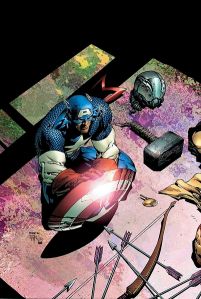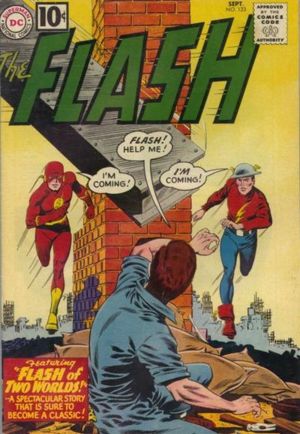So as I discussed in an earlier post, DC and Marvel had very different goals in mind with their 2006 blockbuster crossovers Infinite Crisis and Civil War: Marvel wanted to shake things up. DC wanted to clean house.
This, of course, was not the first time DC had tried. Their attempts to keep both their older franchises as well as their Silver Age descendants resulted in the creation of the Multiverse, a series of parallel earths that would keep the heroes from stepping on each others’ toes. Dawning outright in the seminal story “The Flashes of Two Worlds,” DC could have its cake and eat it, too — all the heroes operated in their own adventures, but there was still the possiility of team-ups. Earth-One’s Barry Allen teamed up with Earth-Two’s Jay Garrick — and soon enough, the Justice League of Earth-One would fight side-by-side with their forebearers from the Second World War, Earth-Two’s Justice Society.
But this soon became a devil’s bargain. New companies were acquired, so that franchises such as Blue Beetle, Captain Marvel, and Uncle Sam were shunted into their own parallel worlds. Then a villainous mirror world was created on Earth-3. While Marvel successfully aped the Multiverse concept in later years to explain time travel, interdimensional incursions, as well as its “What If” series, for DC, the whole concept of the Multiverse became so integral to the mythos — with returning readers and new readers alike being confused by the multiple earths — that by 1985, characters were so bogged down in idiosyncratic continuity (as well as the camp inspired by the 1960s Batman TV show that had infected and tarnished most of DC’s lineup at one point or another) that it became a chore to make sense of them.
And so — they had the Crisis.
To make a long story short, in 1985, Marv Wolfman and George Perez wrote Crisis on Infinite Earths, a 12-issue supersaga that assembled all the heroes of the sprawling multiverse, and banded them together against a common threat: the Anti-Monitor, whose wave of antimatter energy was destroying these parallel universes one by one. The story was integral for several reasons: amongst the deaths in battle were Kara Zor-El — also known as the first Supergirl — as well as the hero who kick-started the Silver Age: the Flash. Others were simply written out: Earth-2’s older Superman (DC’s attempt to give Superman to the World War II audience that grew up with him as well as a new generation), as well as Earth-Prime’s Superboy were shunted into a “paradise dimension,” where they could no longer cause continuity headaches. As the battle concluded, the Multiverse shook and crumbled, and finally, five worlds were combined into one, with DC finally achieving the one world that Marvel had so long enjoyed. With reboots of the Superman and Wonder Woman franchises by John Byrne and George Perez, as wel as a return to the darker side of Batman following Frank Miller’s megahits Batman: Year One and The Dark Knight Returns, the modern DCU had arrived.
That said, there were some flaws in this new world. Hawkman was perhaps the most egregious problem — presented with multiple origins, one could argue that he was an archeologist… or an Egyptian prince… or a space cop (or spy) from the planet Thanagar. Even characters like Superman had their continuity retroactively changed (a retcon, in comicspeak), giving him a whole new origin story Birthright, as well as other stories muddying the waters — at on point, the planet Krypton temporarily being able to visit in the Phantom Zone. The Flash, meanwhile, was saddled with a wife and two kids. Meanwhile, the wide stable of the DCU was coming up stagnant, crushed under the weight of continuity. Something had to give — and by 2006, it did.
Marvel, meanwhile, had typically aschewed the intercompany crossover, with its few attempts — Secret Wars and its successor, Secret Wars II — seeming less like character-driven stories and more like action figure battles. However, by the mid-2000s, Marvel — led by Brian Michael Bendis, the writer of the unexpected megahit Ultimate Spider-Man — decided to deconstruct the Marvel Universe from the top down. During Avengers: Disassembled, the reality-altering Scarlet Witch lost control of her senses, killing key Avengers such as Hawkeye, Thor, the Vision, and Ant-Man, discrediting others like Iron Man and She-Hulk, and blowing up the Avenger’s mansion before ending her rampage. Disheartened, the Avengers broke up.

Disassembled: Captain America mourns the loss of the team that rescued him in Avengers #503 (November 2004)
While this crossover being Marvel’s most successful — and controversial, considering the Scarlet Witch’s abrupt change — in years, Marvel was determined to recreate the spark. The Avengers were never really gone — only changed. By the end of the year, a new series had come out, with a cast of Avengers unlike any that had been seen before: instead of the mix of big-name characters and B- and C-listers, this was a star-studded team comprised of Captain America, Iron Man, Spider-Man, Wolverine, and Luke Cage. Despite this cast, however, the spark never really seemed to catch — instead of fighting gods and monsters, these New Avengers fought ninjas. Bendis’ trademark decompressed storytelling, perfect for cerebral heroes like Spider-Man, felt somewhat unsubstantial for the rock stars of the Marvel pantheon. It didn’t help that Bendis’ later crossovers, such as Secret War and House of M, also felt thin. While the goals of the series — the ousting of Nick Fury, Director of S.H.I.E.L.D. after the events of Secret War, and the depowering of 90% of the world’s mutants by the Scarlet Witch in House of M — were met, the stories themselves seemed mainly forgettable.
But each of these companies had a plan to clean house, expand their playgrounds, and shake up their core books. But these individual histories would greatly inform how they would do so. Next post!
